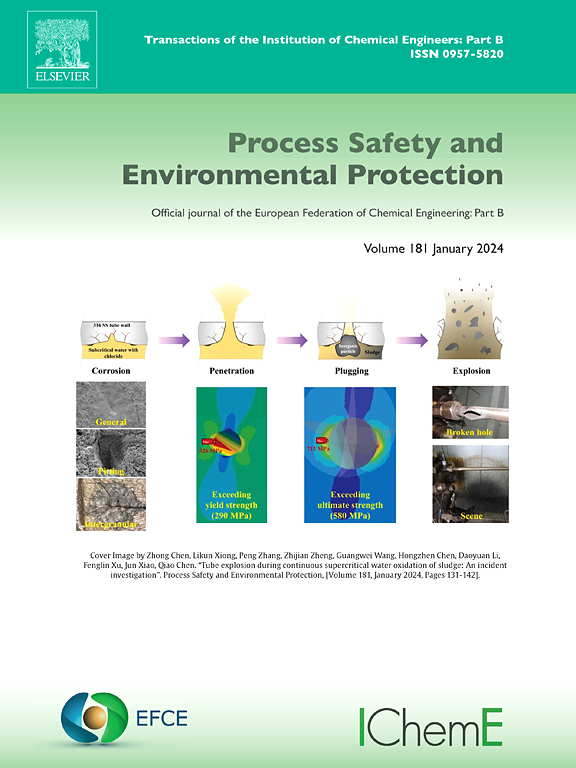Predicting nickel catalyst deactivation in biogas steam and dry reforming for hydrogen production using machine learning
IF 6.9
2区 环境科学与生态学
Q1 ENGINEERING, CHEMICAL
引用次数: 0
Abstract
This study employs Random Forests (RF) and Artificial Neural Networks (ANN) to model the transient behavior of Ni catalyst deactivation during steam and dry reforming of model biogas containing H2S, with a focus on hydrogen production. Deactivation, induced by carbon deposition and sulfur poisoning, is a complex and transient phenomenon demanding precise kinetic mechanisms for accurately predicting Ni catalyst behavior in biogas reforming. Black-box machine learning (ML) models are developed, incorporating catalyst properties, biogas composition, and operating conditions. Encompassing both dry and steam reforming, the ML models aim to predict catalyst behavior, expressed in terms of packed bed reactor exit mole fractions (H2, CO, CH4, and CO2) and conversions (CH4 and CO2). The ML models are trained and tested across a temperature range of 700–900 C with 0–145 ppm of H2S in model biogas (CH4/CO2 ratio varying from 1.0 to 2.0). RF outperforms the ANN across all performance metrics, including overall R2 and root mean squared error (RMSE). The RF achieves a mean overall R2 of 0.979, with training and testing RMSE equal to and respectively. In contrast, the ANN achieves a mean overall R2 of 0.939, with training and testing RMSE equal to and respectively. Moreover, pre-trained RF models are validated with unseen data of dry reforming of biogas containing 30 ppm of H2S (25 data points). It is suggested that 35 % of this unseen experimental data is required to train the RF model for it to predict catalyst deactivation, achieving a validation R sufficiently2> 0.9. The mean overall R2 values attained by the RF fine-tuned on 35 % of the unseen experiment data for both CH4 and CO2 conversions, as well as for all mole fraction predictions, are 0.952 and 0.948, respectively.
利用机器学习预测沼气蒸汽和干转化制氢过程中镍催化剂失活情况
本研究采用随机森林(RF)和人工神经网络(ANN)对含有 H2S 的模型沼气在蒸汽转化和干转化过程中 Ni 催化剂失活的瞬态行为进行建模,重点关注氢气的生产。由碳沉积和硫中毒引起的失活是一种复杂的瞬态现象,需要精确的动力学机制才能准确预测沼气转化过程中 Ni 催化剂的行为。结合催化剂特性、沼气成分和操作条件,开发了黑盒机器学习(ML)模型。ML 模型包括干法转化和蒸汽转化,旨在预测催化剂的行为,以填料床反应器出口摩尔分数(H2、CO、CH4 和 CO2)和转化率(CH4 和 CO2)表示。ML 模型的训练和测试温度范围为 700-900 C,模型沼气中的 H2S 含量为 0-145 ppm(CH4/CO2 比率从 1.0 到 2.0 不等)。在所有性能指标(包括总体 R2 和均方根误差 (RMSE))上,RF 均优于 ANN。RF 的平均总体 R2 为 0.979,训练和测试 RMSE 分别为 6.7×10-3 和 1.47×10-2。相比之下,ANN 的平均总体 R2 为 0.939,训练和测试 RMSE 分别为 2.6×10-2 和 2.55×10-2。此外,预训练的 RF 模型还通过对含有 30 ppm H2S 的沼气(25 个数据点)进行干重整的未见数据进行了验证。结果表明,需要 35% 的未见实验数据来训练射频模型,使其能够预测催化剂失活情况,达到足够的验证 R2>0.9。在 35% 的未见实验数据上微调的 RF 对 CH4 和 CO2 转化率以及所有摩尔分数预测的平均总体 R2 值分别为 0.952 和 0.948。
本文章由计算机程序翻译,如有差异,请以英文原文为准。
求助全文
约1分钟内获得全文
求助全文
来源期刊

Process Safety and Environmental Protection
环境科学-工程:化工
CiteScore
11.40
自引率
15.40%
发文量
929
审稿时长
8.0 months
期刊介绍:
The Process Safety and Environmental Protection (PSEP) journal is a leading international publication that focuses on the publication of high-quality, original research papers in the field of engineering, specifically those related to the safety of industrial processes and environmental protection. The journal encourages submissions that present new developments in safety and environmental aspects, particularly those that show how research findings can be applied in process engineering design and practice.
PSEP is particularly interested in research that brings fresh perspectives to established engineering principles, identifies unsolved problems, or suggests directions for future research. The journal also values contributions that push the boundaries of traditional engineering and welcomes multidisciplinary papers.
PSEP's articles are abstracted and indexed by a range of databases and services, which helps to ensure that the journal's research is accessible and recognized in the academic and professional communities. These databases include ANTE, Chemical Abstracts, Chemical Hazards in Industry, Current Contents, Elsevier Engineering Information database, Pascal Francis, Web of Science, Scopus, Engineering Information Database EnCompass LIT (Elsevier), and INSPEC. This wide coverage facilitates the dissemination of the journal's content to a global audience interested in process safety and environmental engineering.
 求助内容:
求助内容: 应助结果提醒方式:
应助结果提醒方式:


